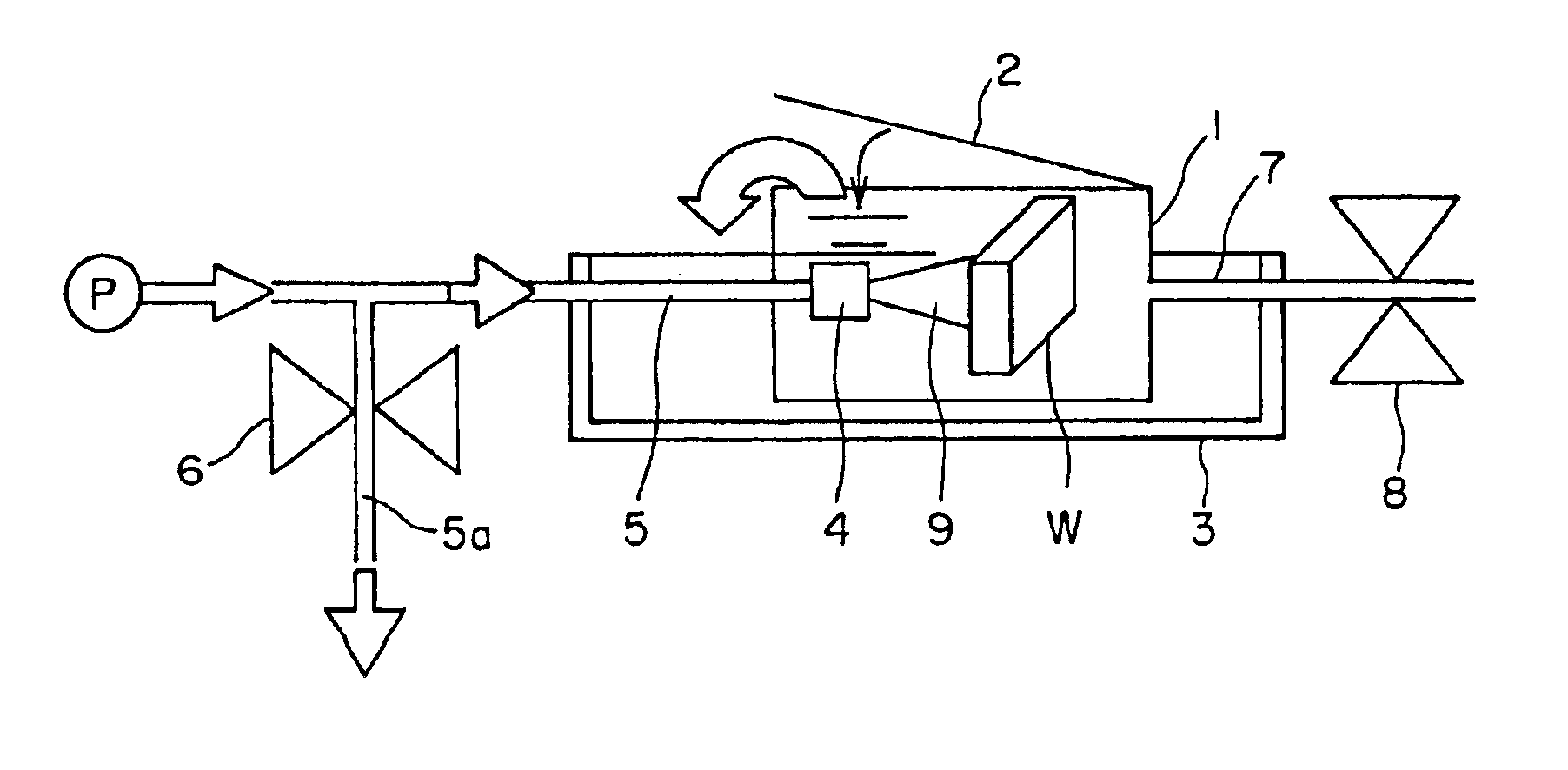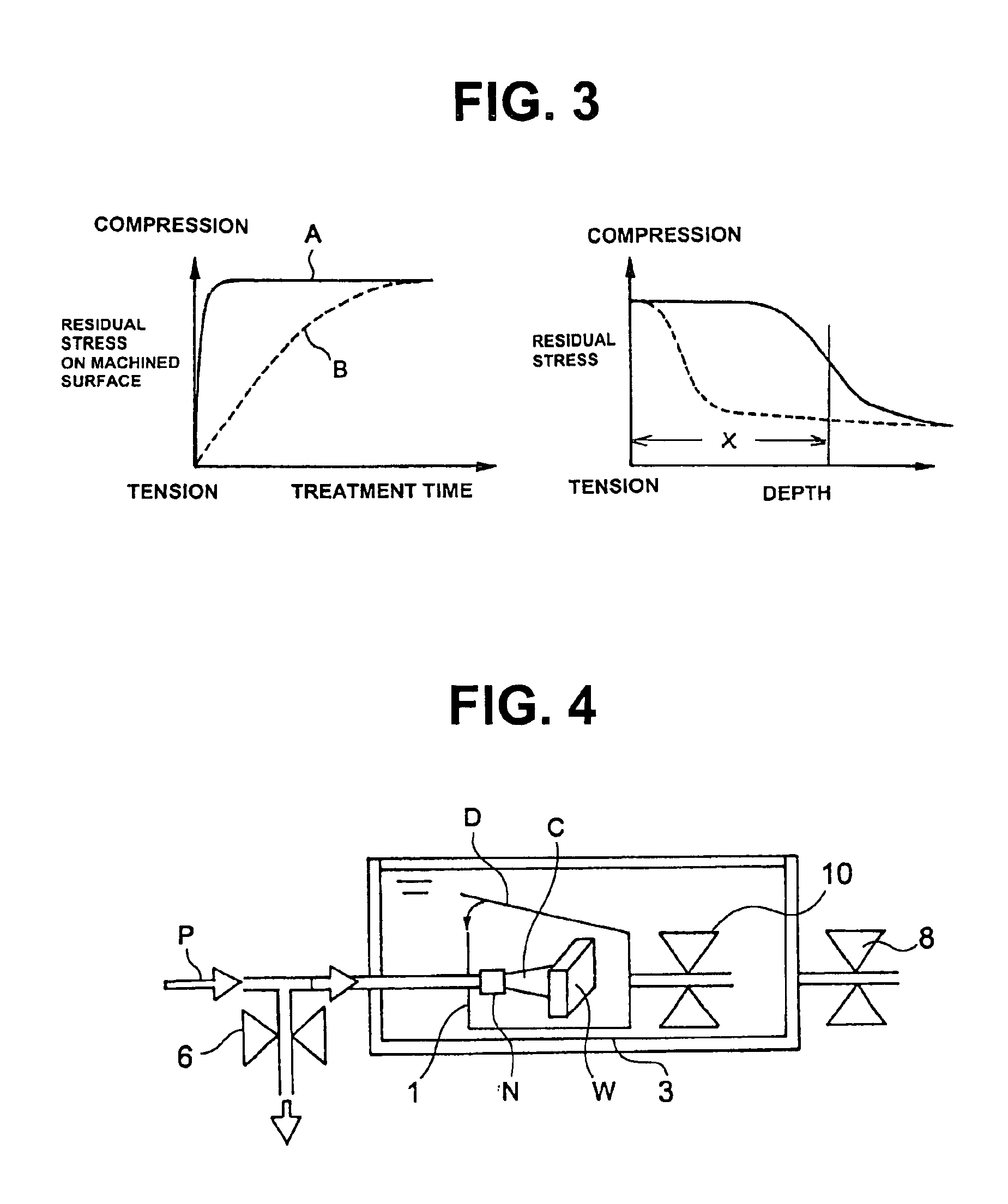Method and devices for peening and cleaning metal surfaces
- Summary
- Abstract
- Description
- Claims
- Application Information
AI Technical Summary
Benefits of technology
Problems solved by technology
Method used
Image
Examples
first embodiment
FIG. 1 is a block diagram of the metal part and other surface modification device involved in the
In FIG. 1, is first vessel 1, which permits a workpiece to be delivered and placed with ease, is configured to be hermetically sealable by means of lid 2, to reform the surface of the workpiece.
A second vessel 3 is capable of accommodating identical first vessel 1, and has a depth larger than the height of first vessel 1 so that it can form appropriate space S in the periphery of the first vessel 1.
Nozzle 4 injects a cavitation jet into first vessel 1.
Conduit 5 supplies the nozzle with a high-pressure fluid from first vessel 1.
Control valve 6 regulates the high-pressure fluid flow rate.
Conduit 7 is a conduit through which the fluid is drained from first vessel 1.
Pressure control valve 8 is located in the said conduct to regulate the pressure in the first vessel 1.
The first vessel 1 may be provided with two or more nozzles. It is preferable, moreover, that flow control valve 6 is located ...
second embodiment
Subsequently, the present invention will be described, based on the figures.
FIG. 2 is a block diagram of the metal part and other surface modification device involved in the second embodiment.
The device in the second embodiment has a shallower second vessel 3 than that in the first embodiment. And the second embodiment is configured so that the fluid will overflow at the upper edge of first vessel 1 while allowing the treatment to be performed just like the first embodiment.
In the second embodiment, it is necessary to pressurize first vessel 1 in the interior. Similarly to the first embodiment, therefore, the second embodiment should have lid 2 closed so that the fluid may overflow through the clearance of lid 2. If a weight is placed on lid 1 of first vessel 1, or a spring with a specified spring constant is used to couple the lid with the vessel, a resistance can be applied to the opening of the lid to mechanically pressurize first vessel 1. This applied pressure is controllable u...
embodiment 4
referred to above has the action described below.
Workpiece 22 is arranged in the fluid in the second vessel 29 and first vessel 21 is placed onto the surface of workpiece 22. Under this condition, a pressurizing fluid is introduced into first vessel 21 and cavitating jet 28 is injected from nozzle 24 into 21 or second vessel 31 to generate cavitation around the jet so that cavitation bubbles will strike workpiece 22. In this stage, the fluid pressure in first vessel21 and the pressure in cavitating jet 28 are controlled, respectively, with pressure control valve 27 and with flow control valve 25. The collapsing impact force of the cavitation bubbles act on the surfaces of the workpiece to bring about a hardening effect on the workpiece surface, an improvement of residual stresses and an enhancement of fatigue strength. The used fluid is discharged to the exterior through gaps between first vessel 21 and the workpiece.
In this embodiment, cavitating jet 28 is generated in the pressuri...
PUM
| Property | Measurement | Unit |
|---|---|---|
| Temperature | aaaaa | aaaaa |
| Force | aaaaa | aaaaa |
| Flow rate | aaaaa | aaaaa |
Abstract
Description
Claims
Application Information
 Login to View More
Login to View More - R&D
- Intellectual Property
- Life Sciences
- Materials
- Tech Scout
- Unparalleled Data Quality
- Higher Quality Content
- 60% Fewer Hallucinations
Browse by: Latest US Patents, China's latest patents, Technical Efficacy Thesaurus, Application Domain, Technology Topic, Popular Technical Reports.
© 2025 PatSnap. All rights reserved.Legal|Privacy policy|Modern Slavery Act Transparency Statement|Sitemap|About US| Contact US: help@patsnap.com



